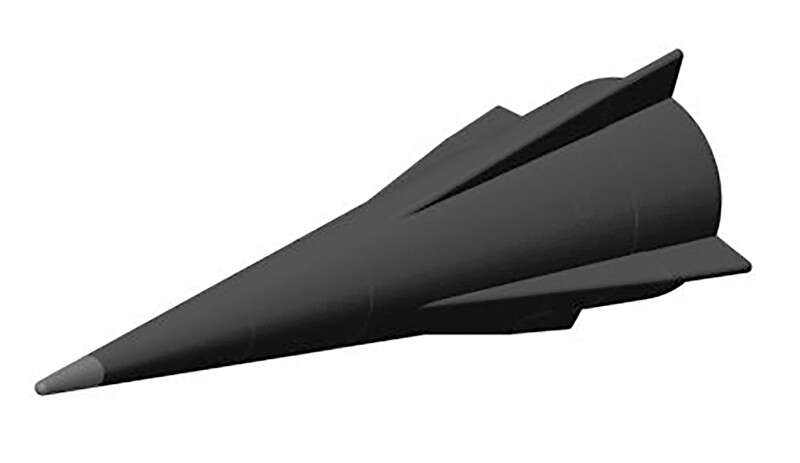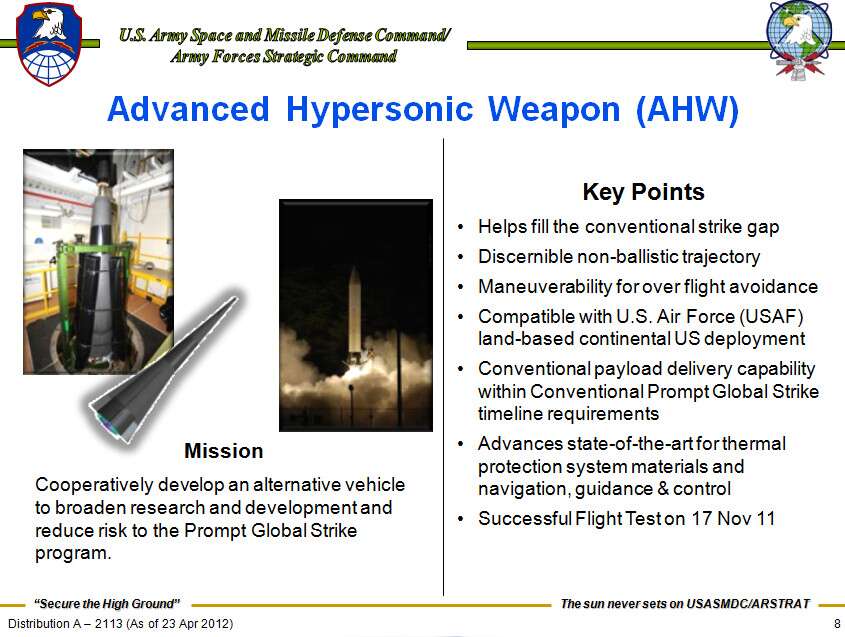Winston
Lorenzo von Matterhorn
- Joined
- Jan 31, 2009
- Messages
- 9,560
- Reaction score
- 1,748
I suspect this is being done as a bargaining chip to allow negotiating from a position of strength when moving to ban these via a treaty.
USAF, Army, and Navy Join Forces To Field America's First Operational Hypersonic Weapon
Concerns about Russian and Chinese threats have pushed the services to work together to try to get the weapon operational in two years.
11 Oct 2018
https://www.thedrive.com/the-war-zo...-americas-first-operational-hypersonic-weapon
Excerpt from a long and very informative article:
The U.S. military’s recent burst of investment into hypersonic technology has created an often confusing morass of different programs spread across the individual services. Now, amid fears that Russia and China are sprinting ahead with similar developments, the U.S. Air Force, Army, and Navy are pooling their efforts on a common unpowered boost-glide vehicle design that could help give each one of them an operational hypersonic weapon in the near-term.
Aviation Week detailed the Pentagon’s latest efforts to combine the Air Force’s Hypersonic Conventional Strike Weapon (HCSW), the Army’s Advanced Hypersonic Weapon (AHW), and the Navy’s Conventional Prompt Strike (CPS) programs into a single effort in a story on Oct. 11, 2018. The goal of this tri-service plan is to be able to field a complete weapon, capable of flying more than six times the speed of sound, by 2021. News that this was all in the works had already begun begun trickling out earlier in 2018.
Since the Navy faces the most challenges in developing a weapon that a ballistic missile submarine will be able to fire, it is in charge of developing the boost-glide vehicle itself, according to Aviation Week. On Oct. 1, 2018, the service awarded a contract worth more than $13 million to the Charles Stark Draper Laboratory in Massachusetts to support that work.
The vehicle itself is a conical design made of a composite of metals and other materials, including carbon fiber, which is derived from the one the Army had been developing for the AHW program. This, in turn, was based on a concept that Sandia National Laboratories had worked on between 1979 and 1985 known as the Sandia Winged Energetic Reentry Vehicle Experiment (SWERVE).
Given this experience, Sandia will produce the actual prototypes and the Army will be responsible for flight testing them, sources told Aviation Week. Each of the three services involved in the program will use their own boosters for ground-, air-, and submarine-launched applications. Without any power of its own, a hypersonic boost glide vehicle requires some other means of getting it up to the appropriate altitude and speed, which has traditionally involved the use of ballistic missiles.
There remain few details about the exact size and capabilities of the new boost-glide vehicle. SWERVE was approximately 100 inches long and could reach a peak of Mach 12 before gliding along at a sustained Mach 8 for a full minute. The Army’s goal for AHW was also a sustained speed of around eight times the speed of sound that would allow the weapon to travel around 3,700 miles in just 35 minutes.
The Pentagon had initially treated AHW as a less risky, more mature backup to the Defense Advanced Research Projects Agency’s (DARPA) more ambitious Force Application and Launch from Continental United States program, or FALCON. That project used half-cone boost-glide vehicle designs known as Hypersonic Test Vehicles (HTV) that held the promise of being faster, more maneuverable, and more accurate than those derived from SWERVE.
These are important considerations for hypersonic vehicles, which by definition fly faster than Mach 5, and derive most of their benefits from that extreme speed and the ability to maneuver at those speeds. We at The War Zone have written in depth about the game-changing nature of these weapons, which open up the possibility of short- or no-notice strikes against time-sensitive and other critical targets, even at extreme ranges. That they can maneuver within the atmosphere along a less predictable flight path makes them even harder to spot and defend against compared to more traditional long-range weapons, such as ballistic missiles.
Just a few of the graphics in the article:


USAF, Army, and Navy Join Forces To Field America's First Operational Hypersonic Weapon
Concerns about Russian and Chinese threats have pushed the services to work together to try to get the weapon operational in two years.
11 Oct 2018
https://www.thedrive.com/the-war-zo...-americas-first-operational-hypersonic-weapon
Excerpt from a long and very informative article:
The U.S. military’s recent burst of investment into hypersonic technology has created an often confusing morass of different programs spread across the individual services. Now, amid fears that Russia and China are sprinting ahead with similar developments, the U.S. Air Force, Army, and Navy are pooling their efforts on a common unpowered boost-glide vehicle design that could help give each one of them an operational hypersonic weapon in the near-term.
Aviation Week detailed the Pentagon’s latest efforts to combine the Air Force’s Hypersonic Conventional Strike Weapon (HCSW), the Army’s Advanced Hypersonic Weapon (AHW), and the Navy’s Conventional Prompt Strike (CPS) programs into a single effort in a story on Oct. 11, 2018. The goal of this tri-service plan is to be able to field a complete weapon, capable of flying more than six times the speed of sound, by 2021. News that this was all in the works had already begun begun trickling out earlier in 2018.
Since the Navy faces the most challenges in developing a weapon that a ballistic missile submarine will be able to fire, it is in charge of developing the boost-glide vehicle itself, according to Aviation Week. On Oct. 1, 2018, the service awarded a contract worth more than $13 million to the Charles Stark Draper Laboratory in Massachusetts to support that work.
The vehicle itself is a conical design made of a composite of metals and other materials, including carbon fiber, which is derived from the one the Army had been developing for the AHW program. This, in turn, was based on a concept that Sandia National Laboratories had worked on between 1979 and 1985 known as the Sandia Winged Energetic Reentry Vehicle Experiment (SWERVE).
Given this experience, Sandia will produce the actual prototypes and the Army will be responsible for flight testing them, sources told Aviation Week. Each of the three services involved in the program will use their own boosters for ground-, air-, and submarine-launched applications. Without any power of its own, a hypersonic boost glide vehicle requires some other means of getting it up to the appropriate altitude and speed, which has traditionally involved the use of ballistic missiles.
There remain few details about the exact size and capabilities of the new boost-glide vehicle. SWERVE was approximately 100 inches long and could reach a peak of Mach 12 before gliding along at a sustained Mach 8 for a full minute. The Army’s goal for AHW was also a sustained speed of around eight times the speed of sound that would allow the weapon to travel around 3,700 miles in just 35 minutes.
The Pentagon had initially treated AHW as a less risky, more mature backup to the Defense Advanced Research Projects Agency’s (DARPA) more ambitious Force Application and Launch from Continental United States program, or FALCON. That project used half-cone boost-glide vehicle designs known as Hypersonic Test Vehicles (HTV) that held the promise of being faster, more maneuverable, and more accurate than those derived from SWERVE.
These are important considerations for hypersonic vehicles, which by definition fly faster than Mach 5, and derive most of their benefits from that extreme speed and the ability to maneuver at those speeds. We at The War Zone have written in depth about the game-changing nature of these weapons, which open up the possibility of short- or no-notice strikes against time-sensitive and other critical targets, even at extreme ranges. That they can maneuver within the atmosphere along a less predictable flight path makes them even harder to spot and defend against compared to more traditional long-range weapons, such as ballistic missiles.
Just a few of the graphics in the article:





